http://bleacherreport.com/articles/...ding-back-sam-bradford-from-being-rams-savior
Injuries Only Thing Holding Back Sam Bradford from Being Rams' Savior
By Cian Fahey, Featured Columnist Feb 12, 2015
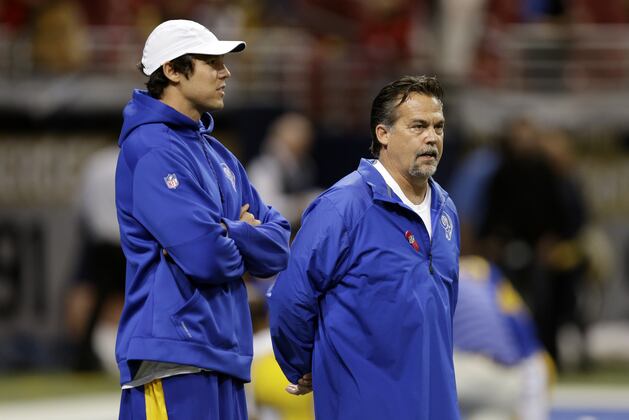
Sam Bradford is a talented quarterback.
Since his rookie season, the positivity for the St. Louis Ramsplayer has slowly shifted toward the dark side of the moon. The majority of the media coverage surrounding Bradford has focused on his sizable contract, injury history and muted statistical production.
Two of those aspects are inarguable.
As the first overall pick of the 2010 NFL draft, Bradford was the final top pick before the introduction of the rookie wage scale. He signed a six-year contract worth $78 million, so his cap hits compared to other young quarterbacks over recent times have been huge.
Compounding that cost is the fact that Bradford has played in only 49 games over the first five seasons. A high ankle sprain cost him six games in 2011 and a torn ACL prematurely ended his fourth season after just seven games. That ACL re-tore during the preseason in 2014, costing Bradford all 16 games of the season.
Injuries aren't predictive moving forward, but it is concerning how often Bradford has missed time on the field dating back to his spell in college.
With the financial cost of Bradford and the potential durability problems, it's easy to craft an argument against the Rams' keeping him on the roster. When you add in his statistical output, you can also suggest that he isn't a viable starter regardless of those separate issues.
This is the piece of the Bradford puzzle that is most often misconstrued.
Most top quarterback prospects don't begin their careers on third base. In fact, most are fortunate to start their careers at home plate because of how the NFL structures the draft to promote parity. If your average top-10 quarterback pick begins his career swinging a bat from his knees, Bradford began his buried up to his shoulders.
As a rookie, Bradford played with Steven Jackson during his prime. Jackson had over 1,200 rushing yards, but the Rams running game as a whole ranked 31st in DVOA, a Football Outsiders metric that measures efficiency on a snap-by-snap basis. Even at that stage, the Rams passing game was better than the running game.
During his first three seasons, the Rams running game ranked 31st,28th and 19th in DVOA. When it ranked 19th in 2012, the passing game ranked 17th even though Bradford's receiving options were Danny Amendola, Brandon Gibson, Chris Givens, Lance Kendricks and Austin Pettis.
For the first three years of his career, Bradford didn't have a running game to rely on, his offensive line was largely incompetent and his receivers were very limited. As such, his statistical output was largely irrelevant for evaluating his performances.
Entering his fourth season, the Rams had attempted to re-tool his supporting cast. Bradford was now at a point where most of his development should have been completed. Therefore, the numbers were expected to improve.
Alas, the front office's best efforts hadn't been good enough.
In 2013, Bradford was still working with a dysfunctional supporting cast. Zac Stacy would eventually ignite the running game, but Daryl Richardson was the initial starter alongside Bradford in the backfield. Richardson averaged 3.3 yards per carry and didn't score a single touchdown over the first four games of the year.
Not only did that balance force Bradford to carry the offense, it also put more pressure on the team's offensive line. A line that was proving to be a liability despite the arrival of Jake Long at left tackle.
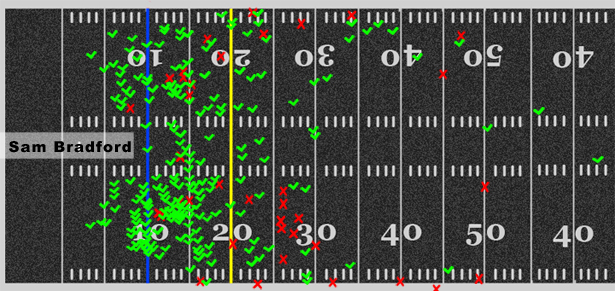
Credit: Cian Fahey
This chart tracks every single pass attempt from Bradford during the seven games he played in 2013. It is not a reflection of incompletionsand completions, but rather accurate and inaccurate throws. Spikes, throwaways and passes tipped at the line of scrimmage were not included.
At first glance, what stands out is where Bradford threw the ball.
Without a running game and with leaky pass protection, it's no surprise that the Rams turned to a short passing attack. Of course, they didn't really turn to it because it's the approach they have relied on throughout Bradford's career.
It would be easy to look at the statistics and consider this a reflection of the quarterback, but instead it should be considered a reflection of the offense as a whole.
To successfully throw the ball deep in the NFL, you need much more than just a quarterback who can throw the ball down the field accurately. You need at least one of A) A strong running game B) An offensive line that can effectively handle four man pass rushes C) Wide receivers who can create separation and/or win at the catch point consistently.
Despite playing 49 games in the NFL, Bradford has never had any of these three key components to work with.
Because defenses didn't respect the running game and could get quick pressure with just four rushers, they rarely put their defensive backs in space. They could sit back in Cover 2 or similar types of defenses that weren't aggressive. For Bradford, this meant that he was regularly throwing the ball into tighter windows while mitigating pressure in the pocket.
As Eli Manning found out during the 2013 season when he was put in a similar situation, it's very difficult to consistently complete passes down the field in these situations. Manning even had a better situation than Bradford because Manning had receivers who were at least capable of creating separation down the field.
This 2nd-and-11 play against the San Francisco 49ers was all too common for Bradford in 2013.
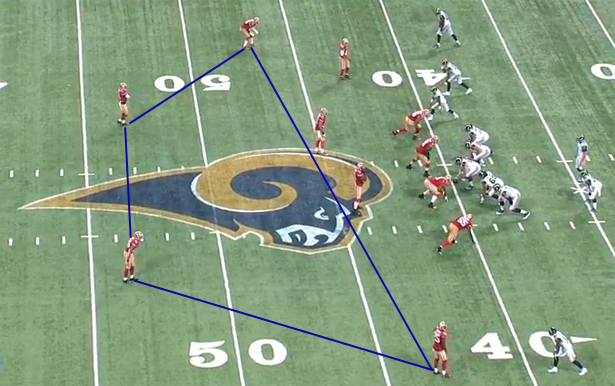
Credit: NFL.com
Considering the down and distance, the formation and the quality of the Rams' rushing attack, the 49ers feel comfortable coming out with two deep safeties and a light box. Bradford has Givens wide to his left, Jared Cook wide to the right, Tavon Austin as the inside slot receiver and Pettis as the outside slot receiver.
His running back in the backfield is going to stay in to block, giving the Rams a six-versus-four protection setup.
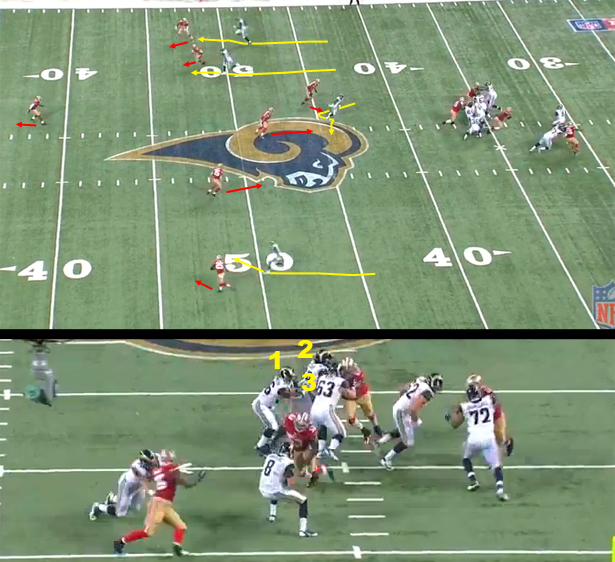
Credit: NFL.com
The 49ers don't blitz at the snap, but they do disguise their four-man rush. Instead of rushing the four down lineman, they drop their left defensive end and bring an inside linebacker from the other side of the center toward the pocket.
Despite the Rams' having six blockers available to them, that linebacker gets a one-on-one opportunity against the running back in space because the left guard doubles the defensive lineman in front of him with the center.
The pass protection attempt from the running back is woeful, meaning that the linebacker is almost immediately attacking Bradford in the pocket. At this point, Bradford has nowhere to go with the football. The four-man rush has provided too much pressure, so all of his receivers are still running their stems downfield.
Austin is an option over the middle, but he has three defenders watching him, and one is in position to break on the ball as Bradford releases it.
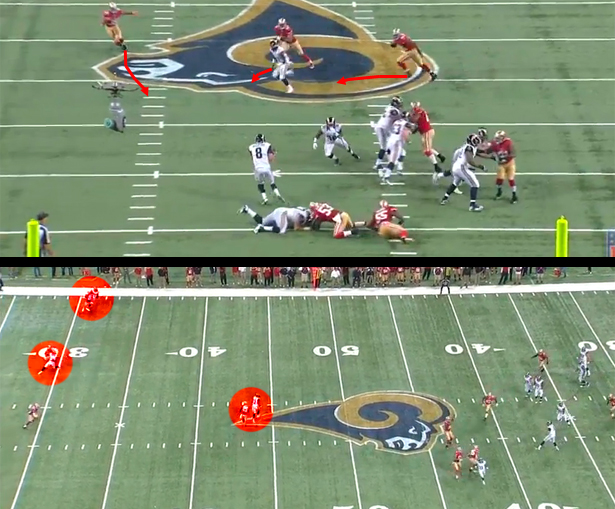
Credit: NFL.com
With his athleticism, Bradford is able to escape from the two incoming rushers and extend the play into the left flat. Despite their quarterback buying them more time to come open, none of the Rams receivers have created separation down the field.
Bradford's best option is Givens, who is running a crossing route over the middle of the field. He hasn't created any separation, but with a perfect throw across his body, Bradford might be able to throw him open.
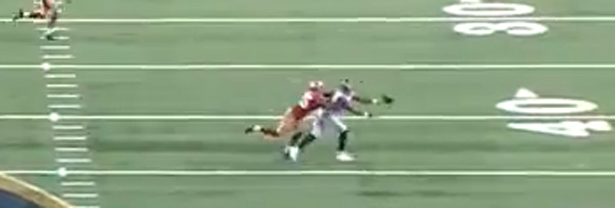
Credit: NFL.com
Givens failed to create any real separation, and his catch radius is almost nonexistent. Therefore, Bradford's near-perfect pass falls incomplete just past his outstretched hands. Despite theincompletion, this was a phenomenal throw from the quarterback.
If he simply had a better quality of target, it would likely have led to a completion, a first down and a big gain. Yet, this exceptionally difficult throw simply landed on the statistic sheet as another incompletion.
This is the type of throw that most quarterbacks have to make only a couple of times each game. For Bradford, this kind of play was what he needed to do more often than not to complete passes down the field. Even when he did make these throws, he couldn't rely on his receivers to catch the ball.
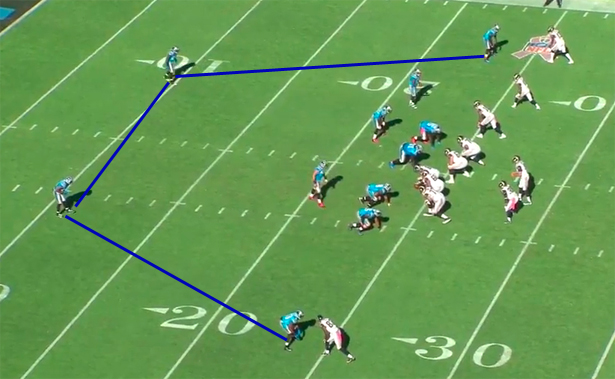
Credit: NFL.com
On this play against the Carolina Panthers, the defense is going to blitz Bradford but only with one extra defender. Because it's 3rd-and-7, the Panthers feel comfortable blitzing Bradford while keeping both safeties deep from the very start of the play.
The defense didn't mask its intentions, and Bradford appeared to know immediately what he was going to do with the ball when he got it at the snap.
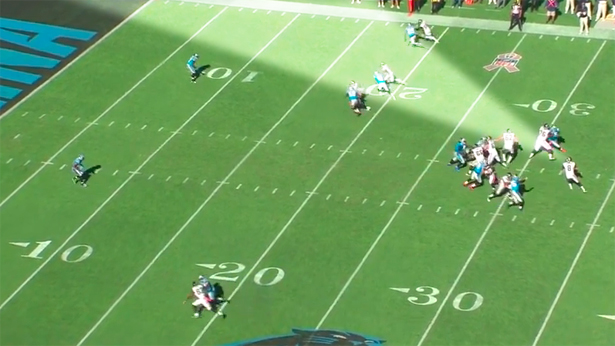
Credit: NFL.com
During his dropback into the pocket, Bradford keeps his eyes to the left side of the defense where he has three receivers running downfield. Meanwhile, the Rams offensive line has accounted for the extra linebacker rushing the passer while still containing the rest of the defensive line.
Although the protection has accounted for every rusher, they aren't winning their matchups, so the pocket is closing on Bradford relatively quickly. He acts faster than the pass rush, though.
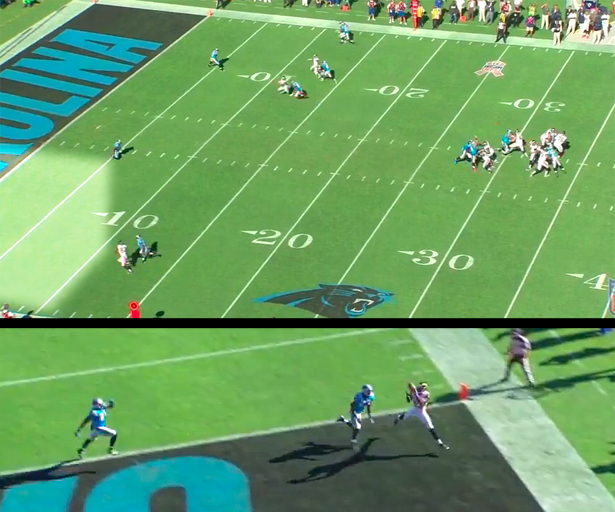
Credit: NFL.com
Bradford adjusts in the pocket to move into more space as his left tackle is pushed backward. As he does this, he brings his eyes back to the left sideline where he has Brian Quick running down the sideline. Because of Bradford's initial eye movement, the safety to that side of the field isn't in position to help the cornerback covering Quick.
With outstanding precision and arm strength, Bradford arcs his pass and pushes the placement toward the sideline.
This means that only Quick can catch the ball, and it should be a comfortable reception in the end zone. However, at this point of his career Quick was very unreliable. He proved to be a competent starter in 2014 as he rounded out his development, but before then he was constantly running poor routes, showing no awareness and dropping accurate passes.
Drops were a constant issue for the Rams offense.
Even with their limited ability to win the ball at the catch point or consistently create separation, the Rams receivers weren't consistent or natural catchers of the ball. In the opinion of Pro Football Focus, Bradford had 21 dropped passes on his 262 attempts.
That is one drop every 12.5 attempts, a ratio that would have ranked him among the worst in the league that season.
Pro Football Focus typically favors the wide receiver more than the quarterback in drop evaluations. Therefore, Bradford was likely let down on a significantly more regular basis than even these analytical numbers imply. Quick and Jared Cook were the Rams' two most physical receivers, but neither were starters.
Instead, Givens and Pettis were still the team's primary options. Givens has some long speed but is a limited route-runner and lacks effectiveness at the catch point. He was relegated to a backup in 2014.Pettis was released by the Rams during the 2014 season.
Bradford's arm talent is among the most impressive in the NFL, but he hasn't been able to show it off because of the receivers he has played with.
Instead, that arm talent has primarily been used to show off his impressive underneath accuracy. As the chart highlights, Bradford was able to show off very impressive consistency when throwing the ball to receivers within 10 yards of the line of scrimmage.
Many of these plays were relatively easy throws, but the ball placement and anticipation of his throws was nonetheless impressive.
If you only watched Bradford's broadcast tape, you would be forgiven for believing that he was a similar player to Alex Smith. Someone who is overly cautious to the point that he hurts his offense. Bradford checks the ball down a lot, but he doesn't shy away from open receivers when given the opportunity to find them.
This play from the Houston Texans game highlights Bradford's decision-making process.
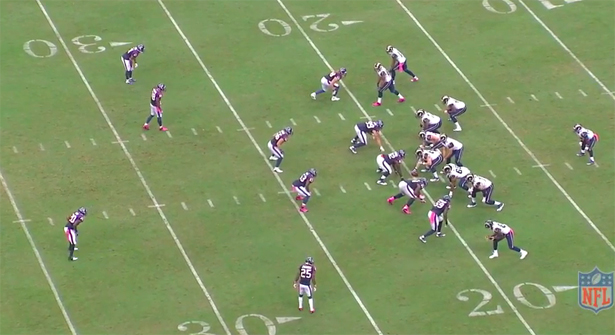
Credit: NFL.com
On 1st-and-10, the Rams have three receivers, a tight end and a running back on the field, but they don't spread the offense out. The Texans defense has its secondary in off coverage with its base defense on the field.
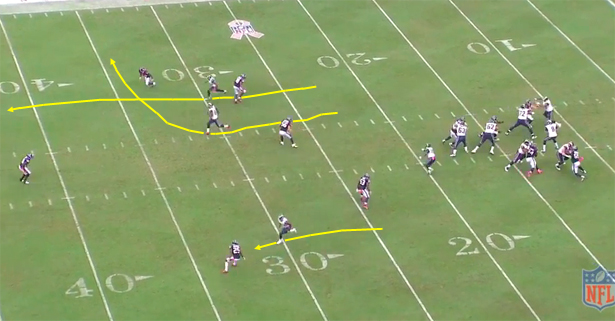
Credit: NFL.com
Despite their soft coverage on the back end, the Texans send five players after the quarterback at the snap. The Rams respond by keeping a tight end in to block, creating a six-versus-five situation for the pass protection.
The extra blocker doesn't help the Rams contain the interior rushers. Those two rushers are aggressively penetrating the pocket past the outside shoulders of their offensive linemen. This pressure prevents Bradford from releasing the ball downfield, but a running lane to escape forward is created.
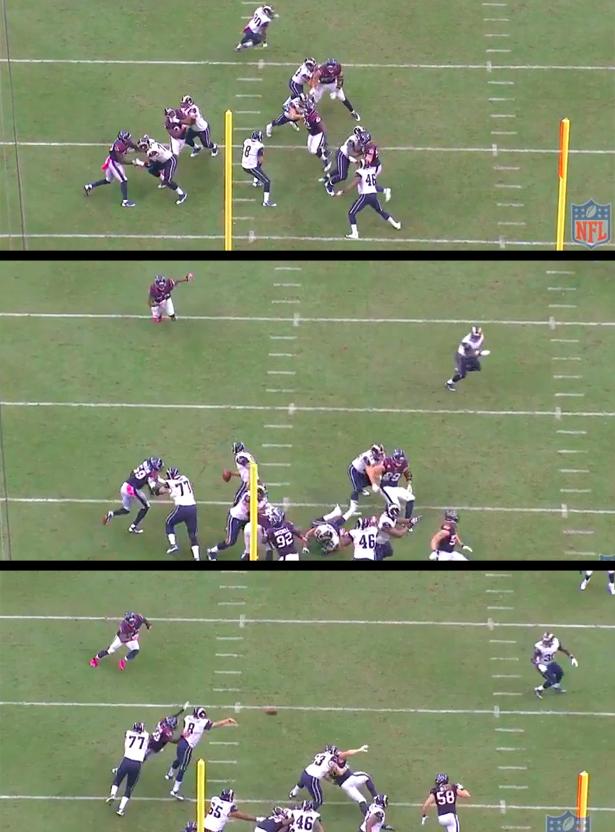
Credit: NFL.com
Bradford is able to step up in the pocket before he hits his own blocker. He is able to maintain his balance and bring his eyes back toward the right flat where Stacy is running. Stacy doesn't have much space in which to work, but Bradford gets the ball to him quickly and accurately so he can turn downfield.
Stacy cuts inside a tackler before falling forward for six yards.
This was the right decision from Bradford. He found the best option to gain yardage when his options downfield were covered. Instead of recklessly forcing the ball downfield for the sake of it, Bradford intelligently set up a more manageable second-down situation and avoided a potential turnover.
Unlike Alex Smith, Bradford isn't predisposed to fear.
It just so happens that his supporting cast puts him in situations where the smarter decision is more often than not to check the ball down. In his final game of the 2013 season, a game that came after two impressive displays from Stacy gave the running game more life, Bradford was able to be more aggressive.
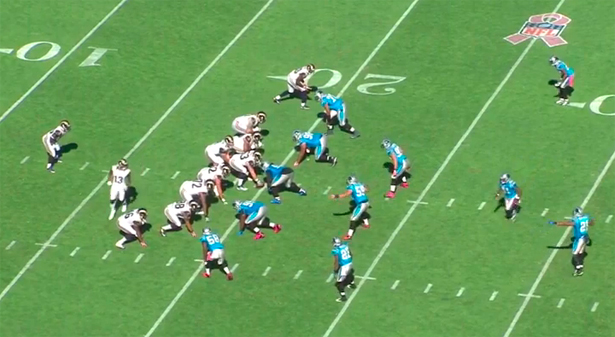
Credit: NFL.com
On this play from that game against the Panthers, the Rams come out with a balanced formation. They have two tight ends to the right side with a receiver tight to the formation also. The wide receiver to the left of the formation is split wider, but not outside of the numbers.
This formation and Stacy's presence in the backfield causes the Panthers to drop a safety into the box.
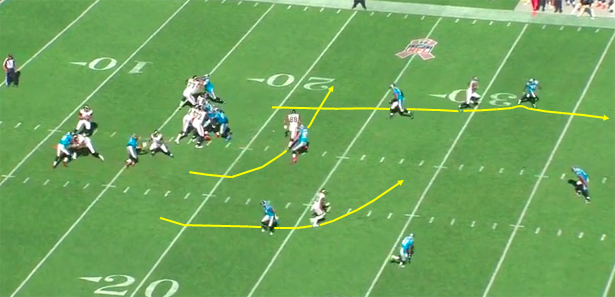
Credit: NFL.com
While keeping two extra blockers in pass protection, the Rams run play action up the middle of the offensive line. This allows the team's offensive line to clamp inside on three defensive linemen, leaving one tight end to contain the left defensive end. A linebacker who attacks from the second level is left alone against Stacy.
On the back end, the defense has just six players in coverage. The Rams are running two crossing routes and one receiver down the seam.
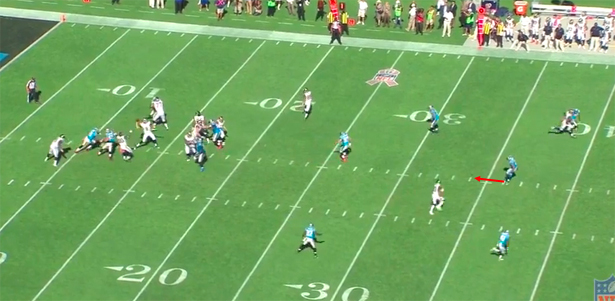
Credit: NFL.com
Because the linebacker and left defensive end have very favorablematchups, they are able to quickly penetrate the pocket and put pressure on Bradford from his right side. Bradford reacts by aggressively stepping forward before delivering the ball downfield.
The quarterback's read was on the deep safety over the middle of the field. When he saw him step forward, Bradford decided to release the ball toward Quick on the seam route.
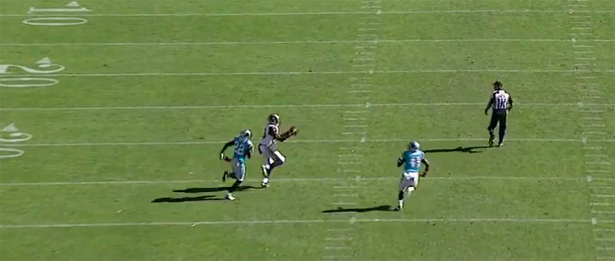
Credit: NFL.com
Against this coverage, Bradford has to be wary of the other cornerback coming across the field. His pass can't hang in the air or it risks being picked off. He must rely on his arm strength and accuracy to split the two defensive backs while leading his receiver downfield.
Bradford throws a perfect pass to allow Quick to catch the ball before carrying on downfield for a 70-plus yard gain.
If Bradford had the Rams' current supporting cast, he would have had a significantly more productive season in 2013.
Kenny Britt and a developed Quick are significantly better starters than Pettis and Givens. Tre Mason is the best running back the Rams have had since Steven Jackson, while the offensive line was significantly better last season even though it can still improve.
With that deplorable supporting cast in 2013, Bradford completed 159 of 262 pass attempts, a completion percentage of 60.7, for 1,687 yards, 14 touchdowns and four interceptions.
All four of Bradford's interceptions came after his passes were tipped, although two of those could be blamed on the quarterback, and he had a couple of dropped interceptions also. Despite those plays, it's still clear that he understands how to take care of the football and diagnose coverages while working in the pocket.
His athleticism has always been somewhat underrated, but it's unclear how comfortable he will be working outside of the pocket after his second ACL tear.
Bradford is a smart quarterback with an understanding of how to work from the pocket and the arm talent to make every necessary throw consistently. He simply hasn't ever been given enough help to be more productive in the NFL.
If he is capable of returning to this form in 2015, he should finally get that opportunity as the Rams have built a roster that is only waiting on him to contend in the NFC.
The Rams aren't sticking with Bradford because they are tied to him. They're not sticking to him solely out of stubbornness also. Neither Jeff Fisher nor Les Snead drafted Bradford, so they shouldn't feel like their jobs are tied to him, even if they will be indirectly this year.
The Rams have stuck with Sam Bradford because he is a very talented quarterback who should be an above-average starter if healthy and given enough support.
Injuries Only Thing Holding Back Sam Bradford from Being Rams' Savior
By Cian Fahey, Featured Columnist Feb 12, 2015

Sam Bradford is a talented quarterback.
Since his rookie season, the positivity for the St. Louis Ramsplayer has slowly shifted toward the dark side of the moon. The majority of the media coverage surrounding Bradford has focused on his sizable contract, injury history and muted statistical production.
Two of those aspects are inarguable.
As the first overall pick of the 2010 NFL draft, Bradford was the final top pick before the introduction of the rookie wage scale. He signed a six-year contract worth $78 million, so his cap hits compared to other young quarterbacks over recent times have been huge.
Compounding that cost is the fact that Bradford has played in only 49 games over the first five seasons. A high ankle sprain cost him six games in 2011 and a torn ACL prematurely ended his fourth season after just seven games. That ACL re-tore during the preseason in 2014, costing Bradford all 16 games of the season.
Injuries aren't predictive moving forward, but it is concerning how often Bradford has missed time on the field dating back to his spell in college.
With the financial cost of Bradford and the potential durability problems, it's easy to craft an argument against the Rams' keeping him on the roster. When you add in his statistical output, you can also suggest that he isn't a viable starter regardless of those separate issues.
This is the piece of the Bradford puzzle that is most often misconstrued.
Most top quarterback prospects don't begin their careers on third base. In fact, most are fortunate to start their careers at home plate because of how the NFL structures the draft to promote parity. If your average top-10 quarterback pick begins his career swinging a bat from his knees, Bradford began his buried up to his shoulders.
As a rookie, Bradford played with Steven Jackson during his prime. Jackson had over 1,200 rushing yards, but the Rams running game as a whole ranked 31st in DVOA, a Football Outsiders metric that measures efficiency on a snap-by-snap basis. Even at that stage, the Rams passing game was better than the running game.
During his first three seasons, the Rams running game ranked 31st,28th and 19th in DVOA. When it ranked 19th in 2012, the passing game ranked 17th even though Bradford's receiving options were Danny Amendola, Brandon Gibson, Chris Givens, Lance Kendricks and Austin Pettis.
For the first three years of his career, Bradford didn't have a running game to rely on, his offensive line was largely incompetent and his receivers were very limited. As such, his statistical output was largely irrelevant for evaluating his performances.
Entering his fourth season, the Rams had attempted to re-tool his supporting cast. Bradford was now at a point where most of his development should have been completed. Therefore, the numbers were expected to improve.
Alas, the front office's best efforts hadn't been good enough.
In 2013, Bradford was still working with a dysfunctional supporting cast. Zac Stacy would eventually ignite the running game, but Daryl Richardson was the initial starter alongside Bradford in the backfield. Richardson averaged 3.3 yards per carry and didn't score a single touchdown over the first four games of the year.
Not only did that balance force Bradford to carry the offense, it also put more pressure on the team's offensive line. A line that was proving to be a liability despite the arrival of Jake Long at left tackle.

Credit: Cian Fahey
This chart tracks every single pass attempt from Bradford during the seven games he played in 2013. It is not a reflection of incompletionsand completions, but rather accurate and inaccurate throws. Spikes, throwaways and passes tipped at the line of scrimmage were not included.
At first glance, what stands out is where Bradford threw the ball.
Without a running game and with leaky pass protection, it's no surprise that the Rams turned to a short passing attack. Of course, they didn't really turn to it because it's the approach they have relied on throughout Bradford's career.
It would be easy to look at the statistics and consider this a reflection of the quarterback, but instead it should be considered a reflection of the offense as a whole.
To successfully throw the ball deep in the NFL, you need much more than just a quarterback who can throw the ball down the field accurately. You need at least one of A) A strong running game B) An offensive line that can effectively handle four man pass rushes C) Wide receivers who can create separation and/or win at the catch point consistently.
Despite playing 49 games in the NFL, Bradford has never had any of these three key components to work with.
Because defenses didn't respect the running game and could get quick pressure with just four rushers, they rarely put their defensive backs in space. They could sit back in Cover 2 or similar types of defenses that weren't aggressive. For Bradford, this meant that he was regularly throwing the ball into tighter windows while mitigating pressure in the pocket.
As Eli Manning found out during the 2013 season when he was put in a similar situation, it's very difficult to consistently complete passes down the field in these situations. Manning even had a better situation than Bradford because Manning had receivers who were at least capable of creating separation down the field.
This 2nd-and-11 play against the San Francisco 49ers was all too common for Bradford in 2013.

Credit: NFL.com
Considering the down and distance, the formation and the quality of the Rams' rushing attack, the 49ers feel comfortable coming out with two deep safeties and a light box. Bradford has Givens wide to his left, Jared Cook wide to the right, Tavon Austin as the inside slot receiver and Pettis as the outside slot receiver.
His running back in the backfield is going to stay in to block, giving the Rams a six-versus-four protection setup.

Credit: NFL.com
The 49ers don't blitz at the snap, but they do disguise their four-man rush. Instead of rushing the four down lineman, they drop their left defensive end and bring an inside linebacker from the other side of the center toward the pocket.
Despite the Rams' having six blockers available to them, that linebacker gets a one-on-one opportunity against the running back in space because the left guard doubles the defensive lineman in front of him with the center.
The pass protection attempt from the running back is woeful, meaning that the linebacker is almost immediately attacking Bradford in the pocket. At this point, Bradford has nowhere to go with the football. The four-man rush has provided too much pressure, so all of his receivers are still running their stems downfield.
Austin is an option over the middle, but he has three defenders watching him, and one is in position to break on the ball as Bradford releases it.

Credit: NFL.com
With his athleticism, Bradford is able to escape from the two incoming rushers and extend the play into the left flat. Despite their quarterback buying them more time to come open, none of the Rams receivers have created separation down the field.
Bradford's best option is Givens, who is running a crossing route over the middle of the field. He hasn't created any separation, but with a perfect throw across his body, Bradford might be able to throw him open.

Credit: NFL.com
Givens failed to create any real separation, and his catch radius is almost nonexistent. Therefore, Bradford's near-perfect pass falls incomplete just past his outstretched hands. Despite theincompletion, this was a phenomenal throw from the quarterback.
If he simply had a better quality of target, it would likely have led to a completion, a first down and a big gain. Yet, this exceptionally difficult throw simply landed on the statistic sheet as another incompletion.
This is the type of throw that most quarterbacks have to make only a couple of times each game. For Bradford, this kind of play was what he needed to do more often than not to complete passes down the field. Even when he did make these throws, he couldn't rely on his receivers to catch the ball.

Credit: NFL.com
On this play against the Carolina Panthers, the defense is going to blitz Bradford but only with one extra defender. Because it's 3rd-and-7, the Panthers feel comfortable blitzing Bradford while keeping both safeties deep from the very start of the play.
The defense didn't mask its intentions, and Bradford appeared to know immediately what he was going to do with the ball when he got it at the snap.

Credit: NFL.com
During his dropback into the pocket, Bradford keeps his eyes to the left side of the defense where he has three receivers running downfield. Meanwhile, the Rams offensive line has accounted for the extra linebacker rushing the passer while still containing the rest of the defensive line.
Although the protection has accounted for every rusher, they aren't winning their matchups, so the pocket is closing on Bradford relatively quickly. He acts faster than the pass rush, though.

Credit: NFL.com
Bradford adjusts in the pocket to move into more space as his left tackle is pushed backward. As he does this, he brings his eyes back to the left sideline where he has Brian Quick running down the sideline. Because of Bradford's initial eye movement, the safety to that side of the field isn't in position to help the cornerback covering Quick.
With outstanding precision and arm strength, Bradford arcs his pass and pushes the placement toward the sideline.
This means that only Quick can catch the ball, and it should be a comfortable reception in the end zone. However, at this point of his career Quick was very unreliable. He proved to be a competent starter in 2014 as he rounded out his development, but before then he was constantly running poor routes, showing no awareness and dropping accurate passes.
Drops were a constant issue for the Rams offense.
Even with their limited ability to win the ball at the catch point or consistently create separation, the Rams receivers weren't consistent or natural catchers of the ball. In the opinion of Pro Football Focus, Bradford had 21 dropped passes on his 262 attempts.
That is one drop every 12.5 attempts, a ratio that would have ranked him among the worst in the league that season.
Pro Football Focus typically favors the wide receiver more than the quarterback in drop evaluations. Therefore, Bradford was likely let down on a significantly more regular basis than even these analytical numbers imply. Quick and Jared Cook were the Rams' two most physical receivers, but neither were starters.
Instead, Givens and Pettis were still the team's primary options. Givens has some long speed but is a limited route-runner and lacks effectiveness at the catch point. He was relegated to a backup in 2014.Pettis was released by the Rams during the 2014 season.
Bradford's arm talent is among the most impressive in the NFL, but he hasn't been able to show it off because of the receivers he has played with.
Instead, that arm talent has primarily been used to show off his impressive underneath accuracy. As the chart highlights, Bradford was able to show off very impressive consistency when throwing the ball to receivers within 10 yards of the line of scrimmage.
Many of these plays were relatively easy throws, but the ball placement and anticipation of his throws was nonetheless impressive.
If you only watched Bradford's broadcast tape, you would be forgiven for believing that he was a similar player to Alex Smith. Someone who is overly cautious to the point that he hurts his offense. Bradford checks the ball down a lot, but he doesn't shy away from open receivers when given the opportunity to find them.
This play from the Houston Texans game highlights Bradford's decision-making process.

Credit: NFL.com
On 1st-and-10, the Rams have three receivers, a tight end and a running back on the field, but they don't spread the offense out. The Texans defense has its secondary in off coverage with its base defense on the field.

Credit: NFL.com
Despite their soft coverage on the back end, the Texans send five players after the quarterback at the snap. The Rams respond by keeping a tight end in to block, creating a six-versus-five situation for the pass protection.
The extra blocker doesn't help the Rams contain the interior rushers. Those two rushers are aggressively penetrating the pocket past the outside shoulders of their offensive linemen. This pressure prevents Bradford from releasing the ball downfield, but a running lane to escape forward is created.

Credit: NFL.com
Bradford is able to step up in the pocket before he hits his own blocker. He is able to maintain his balance and bring his eyes back toward the right flat where Stacy is running. Stacy doesn't have much space in which to work, but Bradford gets the ball to him quickly and accurately so he can turn downfield.
Stacy cuts inside a tackler before falling forward for six yards.
This was the right decision from Bradford. He found the best option to gain yardage when his options downfield were covered. Instead of recklessly forcing the ball downfield for the sake of it, Bradford intelligently set up a more manageable second-down situation and avoided a potential turnover.
Unlike Alex Smith, Bradford isn't predisposed to fear.
It just so happens that his supporting cast puts him in situations where the smarter decision is more often than not to check the ball down. In his final game of the 2013 season, a game that came after two impressive displays from Stacy gave the running game more life, Bradford was able to be more aggressive.

Credit: NFL.com
On this play from that game against the Panthers, the Rams come out with a balanced formation. They have two tight ends to the right side with a receiver tight to the formation also. The wide receiver to the left of the formation is split wider, but not outside of the numbers.
This formation and Stacy's presence in the backfield causes the Panthers to drop a safety into the box.

Credit: NFL.com
While keeping two extra blockers in pass protection, the Rams run play action up the middle of the offensive line. This allows the team's offensive line to clamp inside on three defensive linemen, leaving one tight end to contain the left defensive end. A linebacker who attacks from the second level is left alone against Stacy.
On the back end, the defense has just six players in coverage. The Rams are running two crossing routes and one receiver down the seam.

Credit: NFL.com
Because the linebacker and left defensive end have very favorablematchups, they are able to quickly penetrate the pocket and put pressure on Bradford from his right side. Bradford reacts by aggressively stepping forward before delivering the ball downfield.
The quarterback's read was on the deep safety over the middle of the field. When he saw him step forward, Bradford decided to release the ball toward Quick on the seam route.

Credit: NFL.com
Against this coverage, Bradford has to be wary of the other cornerback coming across the field. His pass can't hang in the air or it risks being picked off. He must rely on his arm strength and accuracy to split the two defensive backs while leading his receiver downfield.
Bradford throws a perfect pass to allow Quick to catch the ball before carrying on downfield for a 70-plus yard gain.
If Bradford had the Rams' current supporting cast, he would have had a significantly more productive season in 2013.
Kenny Britt and a developed Quick are significantly better starters than Pettis and Givens. Tre Mason is the best running back the Rams have had since Steven Jackson, while the offensive line was significantly better last season even though it can still improve.
With that deplorable supporting cast in 2013, Bradford completed 159 of 262 pass attempts, a completion percentage of 60.7, for 1,687 yards, 14 touchdowns and four interceptions.
All four of Bradford's interceptions came after his passes were tipped, although two of those could be blamed on the quarterback, and he had a couple of dropped interceptions also. Despite those plays, it's still clear that he understands how to take care of the football and diagnose coverages while working in the pocket.
His athleticism has always been somewhat underrated, but it's unclear how comfortable he will be working outside of the pocket after his second ACL tear.
Bradford is a smart quarterback with an understanding of how to work from the pocket and the arm talent to make every necessary throw consistently. He simply hasn't ever been given enough help to be more productive in the NFL.
If he is capable of returning to this form in 2015, he should finally get that opportunity as the Rams have built a roster that is only waiting on him to contend in the NFC.
The Rams aren't sticking with Bradford because they are tied to him. They're not sticking to him solely out of stubbornness also. Neither Jeff Fisher nor Les Snead drafted Bradford, so they shouldn't feel like their jobs are tied to him, even if they will be indirectly this year.
The Rams have stuck with Sam Bradford because he is a very talented quarterback who should be an above-average starter if healthy and given enough support.
